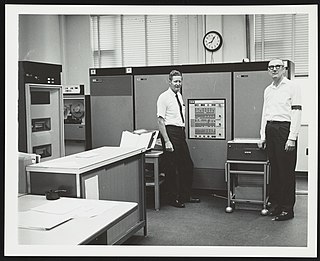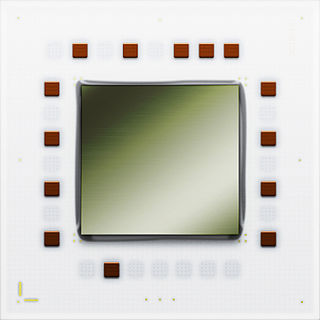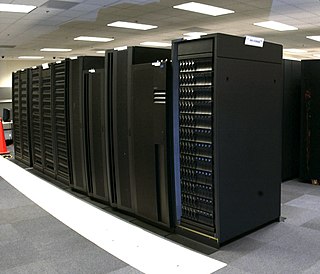Related Research Articles

The IBM 3270 is a family of block oriented display and printer computer terminals introduced by IBM in 1971 and normally used to communicate with IBM mainframes. The 3270 was the successor to the IBM 2260 display terminal. Due to the text color on the original models, these terminals are informally known as green screen terminals. Unlike a character-oriented terminal, the 3270 minimizes the number of I/O interrupts required by transferring large blocks of data known as data streams, and uses a high speed proprietary communications interface, using coaxial cable.
Systems Network Architecture (SNA) is IBM's proprietary networking architecture, created in 1974. It is a complete protocol stack for interconnecting computers and their resources. SNA describes formats and protocols but, in itself, is not a piece of software. The implementation of SNA takes the form of various communications packages, most notably Virtual Telecommunications Access Method (VTAM), the mainframe software package for SNA communications.
Internet Small Computer Systems Interface or iSCSI is an Internet Protocol-based storage networking standard for linking data storage facilities. iSCSI provides block-level access to storage devices by carrying SCSI commands over a TCP/IP network. iSCSI facilitates data transfers over intranets and to manage storage over long distances. It can be used to transmit data over local area networks (LANs), wide area networks (WANs), or the Internet and can enable location-independent data storage and retrieval.

The IBM 1800 Data Acquisition and Control System (DACS) was a process control variant of the IBM 1130 with two extra instructions, extra I/O capabilities, 'selector channel like' cycle-stealing capability and three hardware index registers.
Virtual Telecommunications Access Method (VTAM) is the IBM subsystem that implements Systems Network Architecture (SNA) for mainframe environments. VTAM provides an application programming interface (API) for communication applications, and controls communication equipment such as adapters and controllers. In modern terminology, VTAM provides a communication stack and device drivers.

The IBM 3790 Communications System was one of the first distributed computing platforms. The 3790 was developed by IBM's Data Processing Division (DPD) and announced in 1974. It preceded the IBM 8100, announced in 1979.
RETAIN is a mainframe based database system, accessed via IBM 3270 terminals, used internally within IBM providing service support to IBM field personnel and customers.
A telecommunication control unit (TCU), line control unit, or terminal control unit (although terminal control unit may also refer to a terminal cluster controller) is a Front-end processor for mainframes and some minicomputers which supports attachment of one or more telecommunication lines. TCUs free processors from handling the data coming in and out of RS-232 ports. The TCU can support multiple terminals, sometimes hundreds. Many of these TCUs can support RS-232 when it is required, although there are other serial interfaces as well.

The POWER4 is a microprocessor developed by International Business Machines (IBM) that implemented the 64-bit PowerPC and PowerPC AS instruction set architectures. Released in 2001, the POWER4 succeeded the POWER3 and RS64 microprocessors, enabling RS/6000 and eServer iSeries models of AS/400 computer servers to run on the same processor, as a step toward converging the two lines. The POWER4 was a multicore microprocessor, with two cores on a single die, the first non-embedded microprocessor to do so. POWER4 Chip was first commercially available multiprocessor chip. The original POWER4 had a clock speed of 1.1 and 1.3 GHz, while an enhanced version, the POWER4+, reached a clock speed of 1.9 GHz. The PowerPC 970 is a derivative of the POWER4.

A front-end processor (FEP), or a communications processor, is a small-sized computer which interfaces to the host computer a number of networks, such as SNA, or a number of peripheral devices, such as terminals, disk units, printers and tape units. Data is transferred between the host computer and the front-end processor using a high-speed parallel interface. The front-end processor communicates with peripheral devices using slower serial interfaces, usually also through communication networks. The purpose is to off-load from the host computer the work of managing the peripheral devices, transmitting and receiving messages, packet assembly and disassembly, error detection, and error correction. Two examples are the IBM 3705 Communications Controller and the Burroughs Data Communications Processor.

The IBM 6580 Displaywriter System is a 16-bit microcomputer that was marketed and sold by IBM's Office Products Division primarily as a word processor. Announced on June 17, 1980 and effectively withdrawn from marketing on July 2, 1986, the system was sold with a 5 MHz Intel 8086, 128 KB to 448 KB of RAM, a swivel-mounted monochrome CRT monitor, a detached keyboard, a detached 8" floppy disk drive enclosure with one or two drives, and a detached daisy wheel printer, or Selectric typewriter printer. The primary operating system for the Displaywriter is IBM's internally developed word processing software titled "Textpack", but UCSD p-System, CP/M-86, and MS-DOS were also offered by IBM, Digital Research, and CompuSystems, respectively.

The IBM 3705 Communications Controller is a simple computer which attaches to an IBM System/360 or System/370. Its purpose is to connect communication lines to the mainframe channel. It was a first communications controller of the popular IBM 37xx series. It was announced in March 1972. Designed for semiconductor memory which was not ready at the time of announcement, the 3705-I had to use 1.2 microsecond core storage; the later 3705-II uses 1.0 microsecond SRAM. Solid Logic Technology components, similar to those in S/370, were used.

IBM 37xx is a family of IBM Systems Network Architecture (SNA) programmable communications controllers used mainly in mainframe environments.
The IBM Network Control Program, or NCP, was software that ran on a 37xx communications controller and managed communication with remote devices. NCP provided services comparable to the data link layer and Network Layer functions in the OSI model of a Wide area network.

The IBM Storage product portfolio includes disk, flash, tape, NAS storage products, storage software and services. IBM's approach is to focus on data management.

The IBM 3745 is the latest and last of a 37xx family of communications controllers for the IBM mainframe environment. As of mid-2009 there were an estimated 7,000+ of the larger 3745 models still in active production status, down from 20,000 or more in 2007. The 3745 and associated 3746 models were once heavily used within financial, insurance and retail industries as well as within government agencies globally. However, today most organizations have migrated away from the use of 3745s. IBM's Enterprise Extender and the Communication Controller for Linux on System z (CCL) have largely displaced the older 3745s. IBM announced in September 2002 that it would no longer manufacture new 3745s, but IBM continues to support the hardware by providing worldwide maintenance service, by providing microcode releases and by supporting the associated software including NCP and the virtual telecommunications access method (VTAM). IBM has announced end-of-service dates for Japan, Europe and the Middle East, but has not yet announced end-of-service for the Americas and parts of Asia.
4690 Operating System is a specially designed point of sale (POS) operating system, originally sold by IBM. In 2012, IBM sold its retail business, including this product, to Toshiba, which assumed support. 4690 is widely used by IBM and Toshiba retail customers to run retail systems which run their own applications and others.

270x is a generic name for a family of IBM non-programmable communications controllers used with System/360 and System/370 computers.
Communications Controller for Linux is an IBM software product announced in 2005 that runs under Linux on IBM Z and emulates an IBM 37xx communications controller. CCL runs unmodified IBM Network Control Program (NCP) to allow consolidation of an SNA network infrastructure to IP. According to IBM "SNA traffic enters and leaves CCL as SNA network flows over an OSA adapter. However, your wide area network infrastructure does not need to be SNA. You can consolidate your SNA traffic and use tunneling such as data link switching (DLSw) to encapsulate the SNA communication over an IP network."
References
- ↑ Korzeniowski, Paul (July 20, 1987). "IBM 3720 Cuts Costs". Network World. Retrieved September 1, 2012.